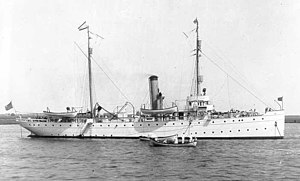 USCGC Seneca, probably circa 1920s
| |
| History | |
|---|---|
| Name |
|
| Namesake | A tribe of the Iroquois Indians[1] |
| Operator | United States Coast Guard |
| Builder | Newport News Shipbuilding[2] |
| Cost | US$244,500[3] |
| Launched | 18 March 1908 [2] |
| Sponsored by | Miss Edith E. Hepburn[1] |
| Commissioned | 12 November 1908[2] |
| Decommissioned | 21 March 1936[2] |
| Fate | Scrapped 1950 |
| General characteristics [2] [Note 1] | |
| Displacement | 1,259 tons[1] |
| Length | 204 ft (62 m) |
| Beam | 34 ft (10 m) |
| Draft | 17 ft 3 in (5.26 m) |
| Propulsion | Triple-expansion steam engine, 20 in (0.51 m), 32 in (0.81 m), 52 in (1.3 m) diameter X 36 in (0.91 m) stroke; two boilers |
| Speed | 11.2 maximum (1930) |
| Complement | |
| Armament | 4 × 6-pounder (57 mm (2.2 in)) rapid fire guns (1908) |
USCGC Seneca, or before 1915 USRC Seneca, was a United States Coast Guard cutter built and commissioned as a "derelict destroyer" with the specific mission of locating and then destroying abandoned shipwrecks that were still afloat and were a menace to navigation. She was designed with excellent sea-keeping qualities, a long cruising range, good towing capabilities, and by necessity the capacity to store a large amount of munitions.[5] She was one of five Coast Guard cutters serving with the U.S. Navy in European waters during World War I.[6]
Cite error: There are <ref group=Note> tags on this page, but the references will not show without a {{reflist|group=Note}} template (see the help page).